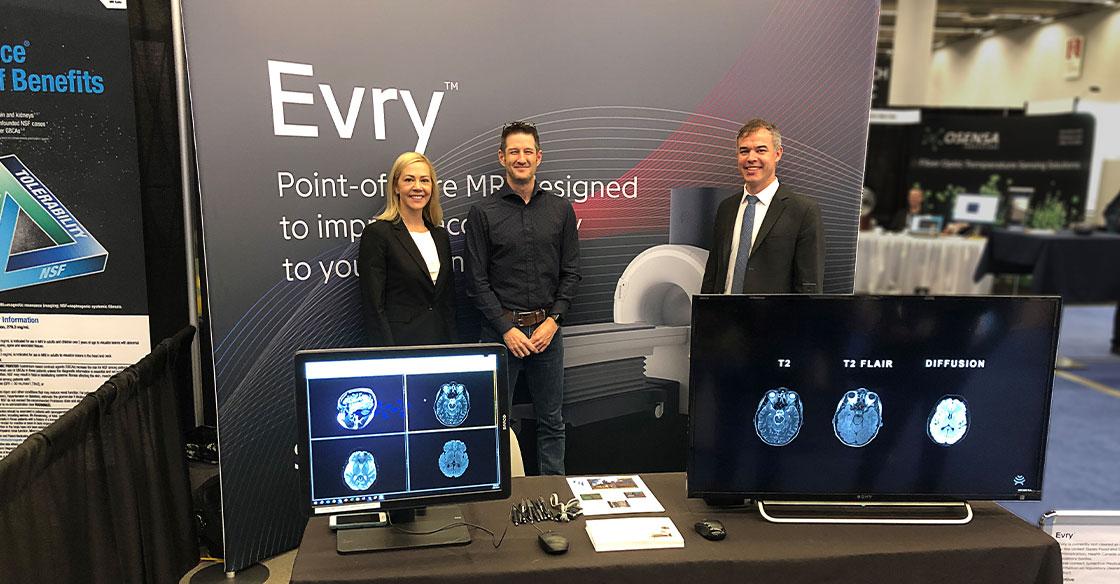
QEII first to have new technology
Originally published on qe2times.ca.
In March 2019, the QEII Health Sciences Centre received delivery of the Evry* MRI machine, a unique instrument designed to provide point-of-care diagnostic information for patients in the emergency department. Funding for this project includes $700,000 from Atlantic Canada Opportunities Agency, $1.26 million from the Research Nova Scotia Trust and $1.4 million of in-kind contributions from Synaptive Medical, Evry’s manufacturer.
Currently, due to safety and design restrictions, MRIs are often housed far away from emergency departments. But according to Dr. Steven Beyea, scientific director for the Biomedical Translational Imaging Centre (BIOTIC) at the QEII, these same limitations are precisely what inspired Synaptive Medical to design the Evry device.
"Synaptive Medical is seeking a collaborative partnership with our healthcare system, and in doing so they’re investing in Nova Scotia.” -Dr. Steven Beyea
“They’ve attempted to re-engineer what an MRI looks like,” he says. “For example, they’ve gotten rid of the requirement for thousands of litres of liquefied helium, a limitation requiring expensive and specialized building ventilation, improving the ability for the machine to sit within the point of care.”
This collaborative research partnership with Synaptive Medical will allow Dr. Beyea’s team to be the first in the world to evaluate the potential impact this new technology could have on emergency medicine patients at the QEII, and beyond.
“This partnership is about being the first to access this technology,” he says. “Synaptive Medical is seeking a collaborative partnership with our healthcare system, and in doing so they’re investing in Nova Scotia.”
While giving local healthcare professionals an opportunity to work hands-on with leading-edge technology, as well as the economic development opportunities, Dr. Beyea believes the province could see a broad spectrum of benefits.
Evry is expected to be up and running by early fall. After the installation, BIOTIC will begin research to evaluate the value the instrument could have to physicians and patients at the QEII’s Charles V. Keating Emergency and Trauma Centre, and to the healthcare system more broadly.
“Given that this is a brand new form of MRI, the goal is to make evidence-informed decisions about whether this should or should not someday become a standard of care within the emergency medicine department,” Dr. Beyea says.
This will involve working in close conjunction with Synaptive Medical.
“We’ve worked with the company and various clinical partners to develop a four-year collaborative research program specifically aimed at evaluating whether, or if, this new technology provides value to the healthcare system in a variety of different ways,” Dr. Beyea explains.
For Dr. Matthias Schmidt, a neuroradiologist at the QEII, the potential advancement of MRI technology is an exciting prospect.
“MRI gives me an opportunity to learn about tissue structure detail and function,” Dr. Schmidt says. “It’s a very versatile procedure that can get into anatomy, physiology and biochemistry and be very sensitive for subtle diseases.”
This in turn, makes MRI an ideal point-of-care device.
“When a patient comes in with an acute neurological symptom the question is: Is this because of a stroke or an inner ear problem?” says Dr. Schmidt. “If it’s a stroke, the patient should be admitted and treated by neurology, but if it’s an inner ear problem then they can be treated as an outpatient. A point-of-care MRI would allow us to diagnose on the day of presentation rather than after a night spent at the hospital.”
“It’s scary for patients who develop acute neurological symptoms when they are either admitted or sent home without all the answers,” says Dr. Schmidt. “As a diagnostician, I think it would be wonderful if I had a tool that would allow me to make a subtle diagnosis more confidently at the time of presentation. An exciting new tool today may become the standard of care tomorrow.” - Dr. Matthias Schmidt
Having an MRI that can safely image patients closer to the emergency department holds considerable appeal for Dr. Schmidt.
“For the first time it makes it practical for really sick people,” he says.
Not content to observe the machine’s effectiveness from a purely clinical perspective, Dr. Beyea will study the patient experience as well.
“A stroke survivor is going to work with our research team to develop feedback questionnaires. It is not only about superior technology, as it is equally as critical for us to understand how this might have changed the patient’s perspective and experience,” explains Dr. Beyea. “Did they see it as something that provided a value or not to their healthcare journey?”
For Dr. Schmidt, this new version of MRI offers a chance to add a valuable new diagnostic resource to his repertoire.
“It’s scary for patients who develop acute neurological symptoms when they are either admitted or sent home without all the answers,” says Dr. Schmidt. “As a diagnostician, I think it would be wonderful if I had a tool that would allow me to make a subtle diagnosis more confidently at the time of presentation. An exciting new tool today may become the standard of care tomorrow.”
* Not yet approved for sale in Canada as a medical device.